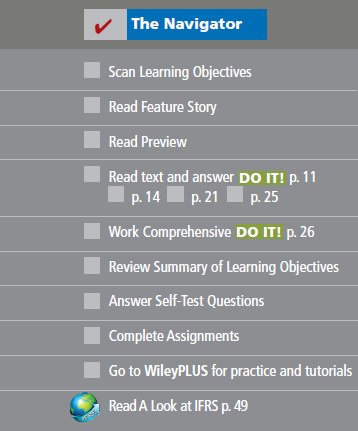Chapter 1 Accounting in Action

The Navigator is a learning system designed to prompt you to use the learning aids in the chapter and set priorities as you study.

Learning Objectives give you a framework for learning the specific concepts covered in the chapter.
Learning Objectives
After studying this chapter, you should be able to:
- Explain what accounting is.
- Identify the users and uses of accounting.
- Understand why ethics is a fundamental business concept.
- Explain generally accepted accounting principles.
- Explain the monetary unit assumption and the economic entity assumption.
- State the accounting equation, and define its components.
- Analyze the effects of business transactions on the accounting equation.
- Understand the four financial statements and how they are prepared.
![]()
Feature Story
Knowing the Numbers
Many students who take this course do not plan to be accountants. If you are in that group, you might be thinking, “If I'm not going to be an accountant, why do I need to know accounting?” In response, consider the quote from Harold Geneen, the former chairman of IT&T: “To be good at your business, you have to know the numbers—cold.”
Success in any business comes back to ...
Get Financial and Managerial Accounting now with the O’Reilly learning platform.
O’Reilly members experience books, live events, courses curated by job role, and more from O’Reilly and nearly 200 top publishers.

